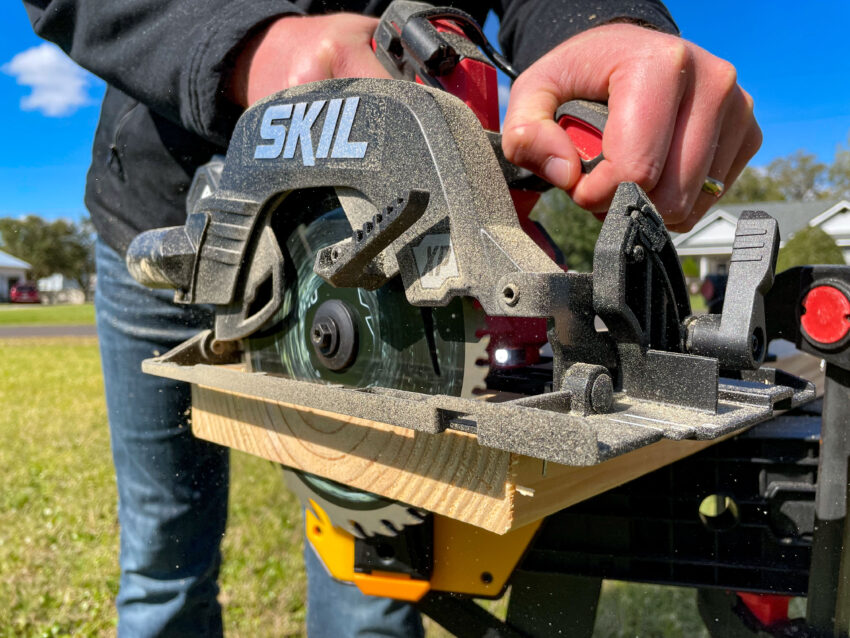Skilsaws, also known as circular saws, are essential tools for both professional woodworkers and DIY enthusiasts. These versatile tools are used for cutting various materials, from wood to metal and plastic.
However, if you’ve ever wondered about the power consumption of a Skilsaw and how many watts it uses, you’ve come to the right place. In this article, we’ll delve into the details of a Skilsaw’s power requirements, its different types, and how to optimize its usage efficiently.
How Many Watts Does a Skilsaw Use?
Before we get into the specifics of a skill saw’s power consumption, let’s first understand what a skill saw is and its various types. A skill saw, often referred to as a circular saw, is a versatile and essential tool for woodworking, construction, and DIY projects.
Additionally, it’s primarily used for cutting through various materials, such as wood, metal, plastic, and more.
Skill saws come in different varieties, including corded and cordless models. Corded skill saws are connected to a power source via a power cord, while cordless ones rely on rechargeable batteries. The power source of a skill saw significantly affects its power consumption.
Power Consumption of Corded Skill Saws

Corded skill saws are the most common type, and their power consumption is relatively easy to determine.
Furthermore, the power rating of a corded skill saw is typically measured in watts (W) or amperes (A). To understand the power consumption of a corded skill saw, it’s crucial to check its wattage rating.
Motor Power: The motor is the heart of a skill saw, and its power rating determines how many watts the saw consumes. For light to medium-duty tasks, skill saws typically have motors ranging from 10 amps (1200 watts) to 15 amps (1800 watts). Heavy-duty models might have motors exceeding 2000 watts.
Voltage: The voltage supplied to the saw also affects its power consumption. Most skill saws operate on a standard household voltage of 120 volts, but some heavy-duty models may require 240 volts.
Additional Features: Some skill saws come with extra features like laser guides, LED lights, or dust collection systems. These features may consume additional power.
The formula to calculate the power consumption in watts is:
Power (W) = Voltage (V) x Current (A)
For example, a skill saw with a 120-volt motor rated at 15 amps consumes:
Power (W) = 120V x 15A = 1800 watts
It’s important to note that the saw’s actual power consumption may vary based on factors like load, cutting depth, and material being cut. However, the rating on the tool is a good indicator of its maximum power usage.
Power Consumption of Cordless Skill Saws
Cordless skill saws operate on rechargeable batteries, which are usually rated in volts (V) and ampere-hours (Ah). Unlike corded saws, determining the exact power consumption in watts is a bit more complex because it depends on the battery’s output voltage and capacity.
The power consumption of cordless skill saws can be calculated as follows:
Power (W) = Voltage (V) x Capacity (Ah)
For example, a cordless skill saw with a 20-volt battery and a capacity of 4.0 Ah consumes:
Power (W) = 20V x 4.0 Ah = 80 watts
Keep in mind that cordless skill saws usually provide power ratings in terms of volts, and their actual power consumption may vary depending on the battery’s state of charge and the cutting conditions.
Efficiency and Safety
Understanding the power consumption of a skill saw is not just about knowing the numbers but also about using the tool efficiently and safely. Here are some practical tips:
Select the Right Tool: Choose a skill saw with the appropriate power rating for your intended tasks. Using an overpowered saw for light jobs can waste energy, while an underpowered saw may struggle with heavier cuts.
Maintain Your Saw: Regular maintenance, including keeping the blade sharp and the saw well-lubricated, can improve efficiency and reduce power consumption.
Safety Precautions: Always follow safety guidelines, wear the necessary protective gear, and ensure proper ventilation when working with a skill saw. This not only enhances safety but also helps prevent overheating, which can increase power consumption.
Conclusion
In summary, the power consumption of a skill saw varies depending on its type, motor rating, and features. Corded skill saws typically have power ratings between 1200 and 2000+ watts, while cordless models operate at lower power levels, depending on their battery specifications.
Understanding a skill saw’s power consumption is essential for selecting the right tool for the job, ensuring efficiency, and maintaining safety. Whether you’re a professional woodworker or a DIY enthusiast, this knowledge will empower you to make informed choices when working with skill saws.
